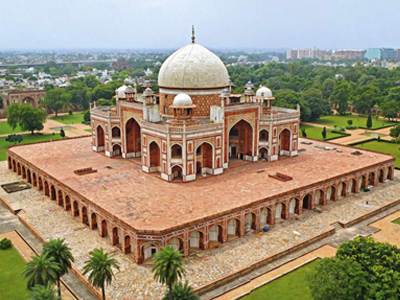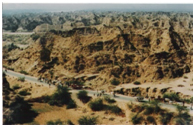Mid-Conference Tour
The mid Conference Tour will be organized as part of conference and no additional charges for the delegates.
Option 1 : Half Day Sightseeing (New Delhi)
 0830 hrs : Pick up from the hotel and proceed for Half Day New Delhi Sightseeing as per the Itinerary given below.
0830 hrs : Pick up from the hotel and proceed for Half Day New Delhi Sightseeing as per the Itinerary given below.
0915 hrs : Visit the 12th century Qutub-Minar in red and buff sandstone is the highest tower in India. It has a diameter of 14.32m at the base and about 2.75m on the top with a height of 72.5m. Qutb-u'd-Din Aibak laid the foundation of Qutab Minar in AD 1199.
The minar was said to have been built to celebrate the victory of Mohammed Ghori, the invader from Afghanistan, over the Rajputs in 1192. He raised the first storey, to which were added three more storeys by his successor and son-in-law, Shamsu'd-Din IItutmish (AD 1211-36). All the storeys are surrounded by a projected balcony encircling the Minar and supported by stone brackets, which are decorated with honeycomb design, more conspicuously in the first storey
 1030 hrs : Later proceed for Humayun Tomb - Humayun's Tomb is situated in Delhi. Humayun's senior widow Bega Begam, popularly known as Haji Begam built the tomb, at a cost of 15 lakh rupees. It was built in the year 1565. It is among the first examples of Mughal architecture, with high arches and a double dome. There are two high double-storey gateways on the west and south that lead to the enclosure. There is a pavilion in the center of the eastern wall and a bath chamber in the center of the northern wall.
1030 hrs : Later proceed for Humayun Tomb - Humayun's Tomb is situated in Delhi. Humayun's senior widow Bega Begam, popularly known as Haji Begam built the tomb, at a cost of 15 lakh rupees. It was built in the year 1565. It is among the first examples of Mughal architecture, with high arches and a double dome. There are two high double-storey gateways on the west and south that lead to the enclosure. There is a pavilion in the center of the eastern wall and a bath chamber in the center of the northern wall.
To enter the tomb's chamber one has to come through the south entrance while the other three sides are covered with mesh wire in white marble. In the quietude of the central chamber lies the tomb, though the actual resting-place of Humayun is directly beneath in an underground chamber. The lofty mausoleum is in the center of the enclosure and rises from a podium faced with series of cells having arched openings.
 1200 Hrs. : Later proceed for India Gate , Situated at the eastern end of Rajpath in Central Delhi is the 42 m high stone arch of victory, renowned as the India Gate. Formally known as the All India War Memorial previously, the foundation stone of this magnanimous structure was laid by the Duke of Connaught in 1921 and dedicated to the nation in 1931 by the then Viceroy, Lord Irwin.
1200 Hrs. : Later proceed for India Gate , Situated at the eastern end of Rajpath in Central Delhi is the 42 m high stone arch of victory, renowned as the India Gate. Formally known as the All India War Memorial previously, the foundation stone of this magnanimous structure was laid by the Duke of Connaught in 1921 and dedicated to the nation in 1931 by the then Viceroy, Lord Irwin.
Designed by Sir Edwin Lutyens, the India Gate stands on a low base of red Bharatpur stone and rises in stages to a huge cornice. Above on both sides is inscribed India, flanked by MCM and to the right, XIX. The names of the 90,000 soldiers of the Indian Army who lost their lives in World War-I, and an additional 13,516 names who sacrificed their lives in the North-West Frontier in the Afghan War of 1919 are inscribed on the walls of this grand construction.
01245 hrs. : Return to guest house/hotel.
Post Conference Tours
This tour is optional for the delegates. The delegates will be charged an amount of $100.
Two Day Tour : Delhi - Agra (210 km/3.5 hrs)
 Visit Agra Fort, a Mughal Architectural tradition that represents the assimilation of different cultures. Akbar began the construction of this massive red sandstone fort on the banks of River Yamuna in 1565. It was ready by 1571 though additions were made until the rule of Shah Jahan, Akbar’s grandson.
Visit Agra Fort, a Mughal Architectural tradition that represents the assimilation of different cultures. Akbar began the construction of this massive red sandstone fort on the banks of River Yamuna in 1565. It was ready by 1571 though additions were made until the rule of Shah Jahan, Akbar’s grandson.
Visit the world famous Taj Mahal built by Shah Jahan in 1560 in memory of his queen Mumtaz Mahal to enshrine her mortal remains. This architectural marvel is a perfectly proportioned masterpiece fashioned from white marble that stands testimony to the skill of 20,000 craftsmen brought together from Persia, Turkey, France and Italy and who took 17 year to complete this ‘Monument of Love in Marble’.
Fatehpur Sikri is also nearby and can be visited. Located 40 kms from Agra, the deserted city of Fatehpur Sikri was built by Emperor Akbar in 1569, in honour of the great Saint Sheikh Salim Chisti who blessed Akbar and prophesized the birth of three sons to the heirless Emperor.
Two Day Tour : Delhi - Jaipur (260 km/5.5 hrs)
 Visit to Amber Fort which is situated in Amber, which is 11 kilometers from Jaipur. Amber, originally, was the capital of the state before Jaipur. It is an old fort, built in 1592 by Raja Man Singh. This fort is also very popularly known as the Amber Palace.
Visit to Amber Fort which is situated in Amber, which is 11 kilometers from Jaipur. Amber, originally, was the capital of the state before Jaipur. It is an old fort, built in 1592 by Raja Man Singh. This fort is also very popularly known as the Amber Palace.
Visit City Palace, it is a splendid blend of the Rajasthani and the Mughal style of architecture. The entire complex is divided into numerous courtyards, gardens and buildings.
Jantar Mantar There are plenty of observatories all over the world, but the Jantar Mantar is considered to be one of the largest observatories ever built. Jaipur was the seat of Maharaja Jai Singh II during the 1720's and this is when this magnificent structure was built here.
The Hawa Mahal or the Palace of Winds was constructed for the royal ladies to watch the royal processions without being seen, all monuments are located in the vicinity of City Palace Complex of Jaipur.
Tour cost to be borne by the individual participant. On prior intimation along with registration, the tour will be booked.
Technical Tours
The organizers will arrange for one day tours to site of erosion management in foothill region and ravine land management. The details of the sites to be visited are as follows. Further details will be put up on the website.
Karnal : A city located in National Capital Region in the state of Haryana, is known as the rice bowl of India. It is centrally located between Delhi and Chandigarh and is 123 km from Delhi. Central Soil Salinity Research Institute is located here pioneered in the rejuvenating the salt affected lands through advanced techniques and feasible approaches. It is an internationally recognised esteemed centre of excellence in salinity research. One can get live demonstrations of Integrated farming system & multi-enterprise model, agroforestry, conservation agriculture and drainage techniques for reclamation and management of salt affected soils and use of poor quality irrigation waters.

Dehradun : It is the capital city of the Indian state Uttarakhand located in the Himalayan foothills. It is the education hub in north India and famous Forest Research Institute and Anthropological Museum are located here. Indian Institute of Soil and Water Conservation (IISWC) has its head quarters here. An exposure visit of participants helps to understand the experiences and impact of developing watershed in different sites in foothill region. IISWC (erstwhile CSWCRTI) is involved in development and dissemination of technologies for conservation of soil, water and other natural resources and their conservative uses. Particularly the participatory water resource development and participatory research executed by CSWCRTI as worth emulating interventions.
 Agra : 200 km distance from New Delhi with driving time of 3 hours. Large scale land development works on Soil Conservation, rejuvenation and restoration of devastated ravine lands in the catchment of river Yamuna and Chambal.
Agra : 200 km distance from New Delhi with driving time of 3 hours. Large scale land development works on Soil Conservation, rejuvenation and restoration of devastated ravine lands in the catchment of river Yamuna and Chambal.
- Last date of Abstract submission 31st August, 2019
- Intimation of acceptance of abstracts 15th September, 2019
- Submission of full length papers 25th September, 2019
- Last date for Registration (without late fees) 20th October, 2019
